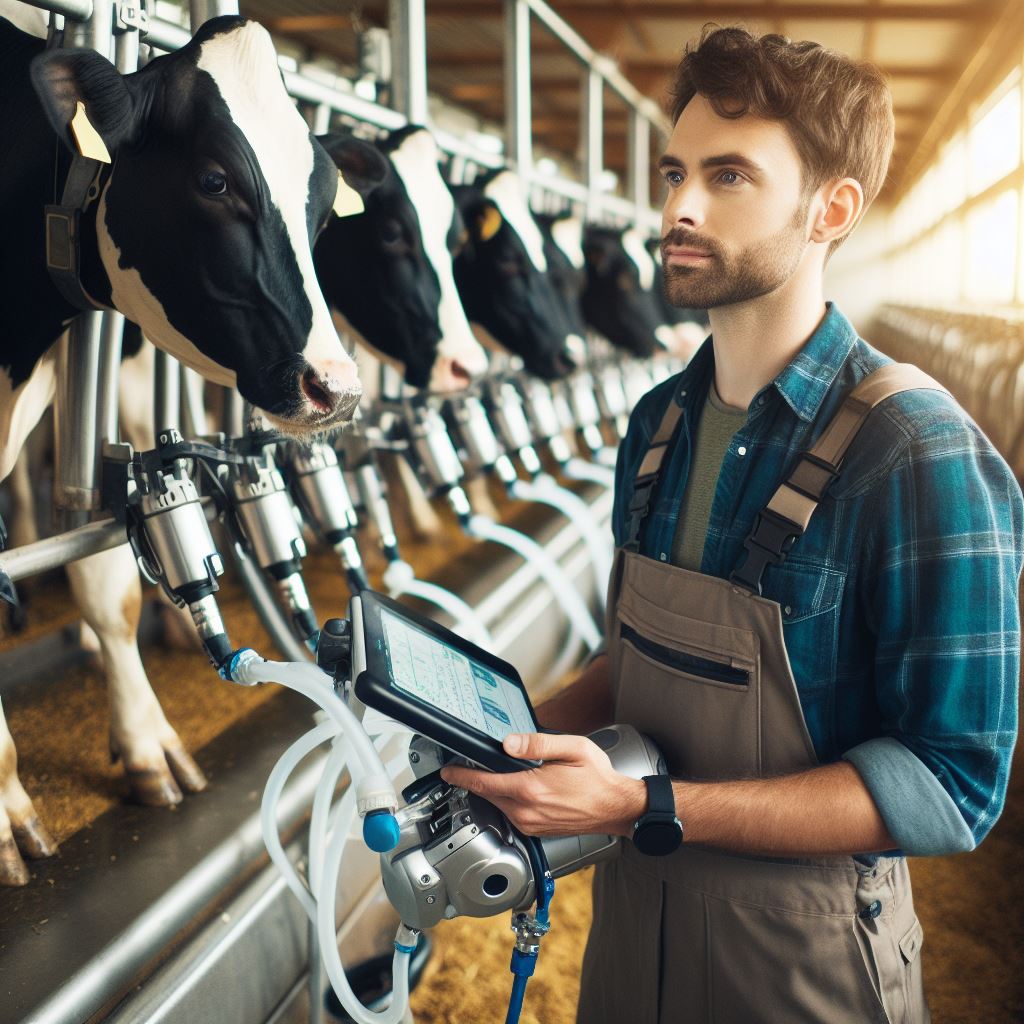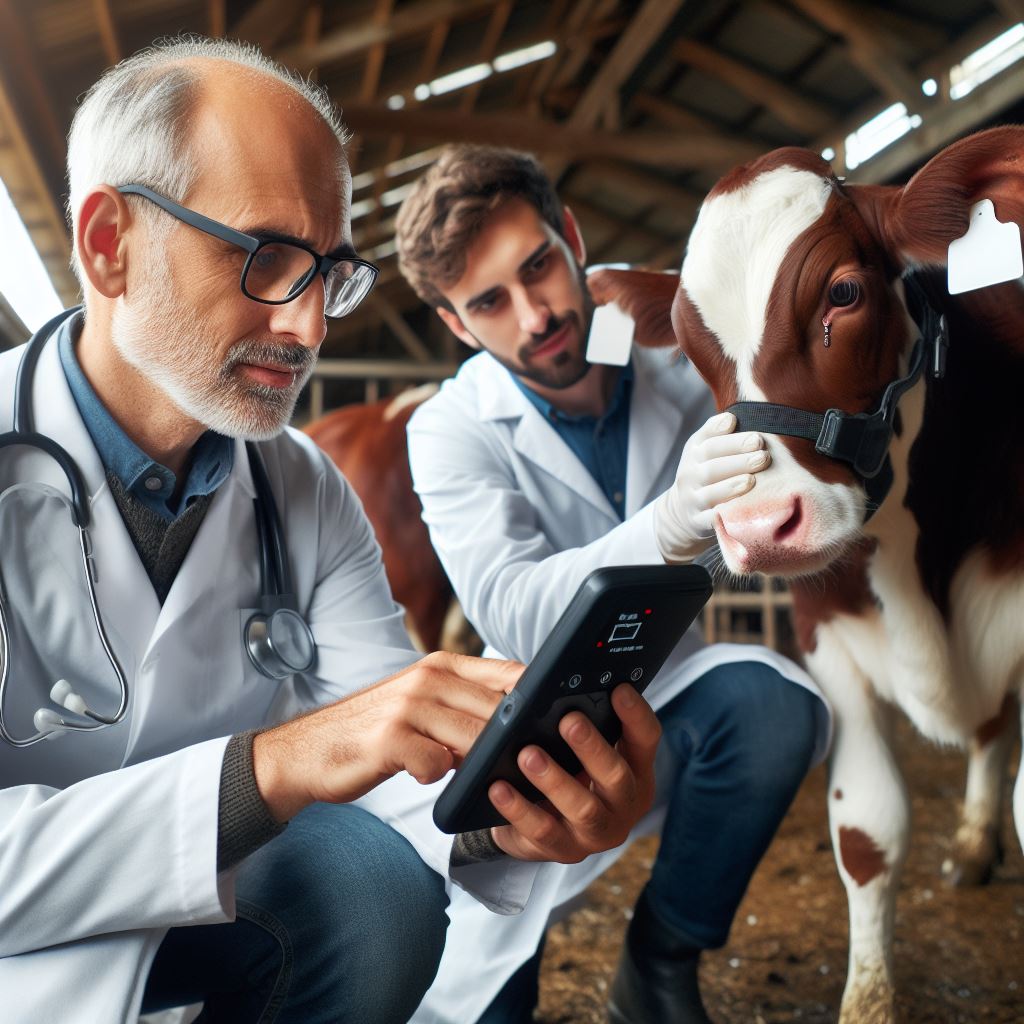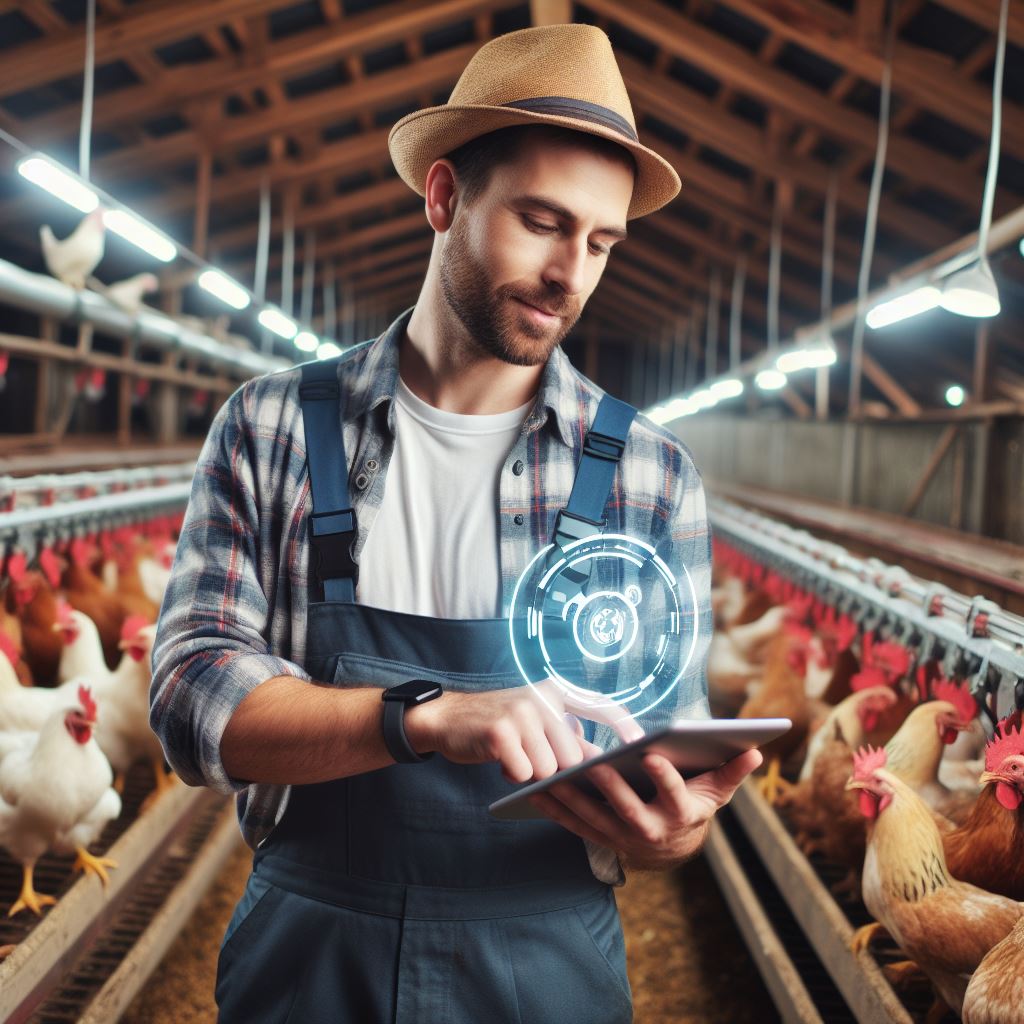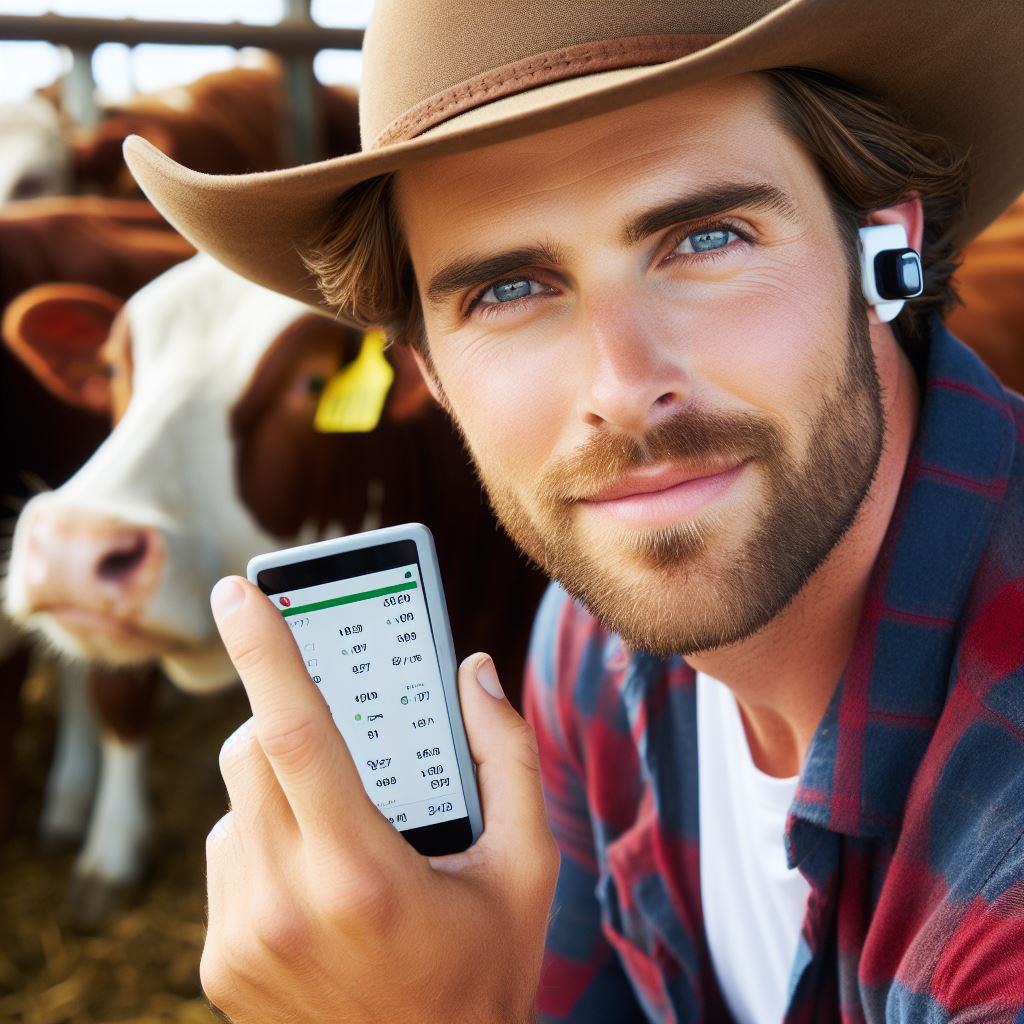Introduction
Dairy farming is an essential industry that provides us with milk, cheese, and other dairy products.
It involves raising cattle and managing their nutrition, health, and reproduction to ensure a consistent milk supply.
Brief explanation of the dairy farming industry
In the dairy farming industry, farmers raise cows to produce milk, which is then processed and sold as various dairy products.
This industry plays a vital role in our daily lives as consumers.
Increasing use of technology in agriculture
With the advancement of technology, the use of robotics in agriculture has been on the rise.
Robotic milkers have become increasingly popular in dairy farming, revolutionizing the way milk is extracted from cows.
These robotic milkers are designed to automate the milking process, reducing the need for manual labor and improving efficiency.
They are capable of milking multiple cows simultaneously, saving time and increasing productivity.
Not only do robotic milkers streamline the milking process, but they also help in monitoring the cows’ health and milk quality.
Integrated sensors collect data on milk production, temperature, and other vital signs, allowing farmers to identify any abnormalities promptly.
Furthermore, robotic milkers provide a more comfortable and stress-free environment for the cows.
The system is designed to mimic the natural grazing and milking rhythm, ensuring the cows are relaxed during the process.
As the dairy farming industry continues to evolve, the adoption of robotic milkers represents a significant leap forward in terms of efficiency, productivity, and animal welfare.
These technological advancements are shaping the future of dairy farming and revolutionizing the way milk is produced.
History of Robotic Milkers
Overview of the traditional milking process
The history of robotic milkers dates back to the 1990s when the first prototypes were developed.
Transform Your Agribusiness
Unlock your farm's potential with expert advice tailored to your needs. Get actionable steps that drive real results.
Get StartedTraditionally, milking cows involved manual labor, with farmers manually attaching milking machines to the cows’ udders.
Introduction of automated milking systems
The introduction of automated milking systems revolutionized the dairy industry, allowing cows to be milked without human intervention.
Early robotic milkers offered several advantages, including increased milking frequency, reduced labor costs, and improved cow comfort.
Limitations of early robotic milkers
These early systems, however, had certain limitations, such as high initial investment costs and limited adaptability to different cow breeds and sizes.
Despite these limitations, the adoption of robotic milkers continued to grow as farmers recognized their long-term benefits.
Long-term benefits of robotic milkers
Automation in milking also led to improved udder health as the robots ensured proper and consistent milking techniques.
Furthermore, robotic milkers allow for individualized cow management, monitoring each cow’s milk production and health parameters.
The robotic milkers use sensors to identify each cow, track milk yield, and adjust milking settings accordingly.
Automated systems also provide valuable data on each cow’s milk production, allowing farmers to make informed decisions for herd management.
Moreover, robotic milkers have enabled farmers to improve milk quality by reducing the risk of contamination and ensuring proper milking hygiene.
The flexibility of automated milking systems allows for the incorporation of other technologies, such as automatic teat cleaning and disinfection.
Additionally, robotic milkers offer cows the freedom to choose when to be milked, reducing stress and enhancing their overall welfare.
The latest generation of robotic milkers incorporates advanced technologies like artificial intelligence and machine learning.
These technologies enable robots to learn individual cow behaviors and adapt the milking process to each cow’s needs.
The integration of automated systems with data analytics provides farmers with real-time insights into milk production and cow health.
Furthermore, robotic milkers contribute to sustainable farming practices by reducing water and energy consumption compared to traditional milking methods.
The continuous development and improvement of robotic milkers have led to increased efficiency and profitability for dairy farmers.
Generally, the history of robotic milkers can be traced back to the 1990s, revolutionizing the traditional milking process.
Advancements in technology have addressed the limitations of early robotic milkers, making them a valuable tool for modern dairy farming.
The benefits of automated milking systems include increased milking frequency, improved milk quality, and enhanced cow welfare.
Furthermore, the integration of advanced technologies allows for individualized cow management and real-time data analytics.
With ongoing developments, robotic milkers continue to shape the future of the dairy industry, paving the way for increased efficiency and sustainability.
Read: Future of Farms: AI & Robotics in Agriculture
Benefits of Robotic Milkers
Robotic milkers have revolutionized the dairy farming industry with their numerous advantages.
Showcase Your Farming Business
Publish your professional farming services profile on our blog for a one-time fee of $200 and reach a dedicated audience of farmers and agribusiness owners.
Publish Your ProfileThese advanced systems not only improve milking efficiency and productivity, but also reduce labor costs and physical strain for farmers.
In addition, they enhance animal welfare and comfort, while providing increased data collection and analysis capabilities.
Improved Milking Efficiency and Productivity
- Robotic milkers allow for continuous milking, resulting in a significant increase in efficiency.
- They are capable of milking multiple cows simultaneously, reducing milking time and increasing overall productivity.
- The automation of the milking process ensures consistent milk quality and reduces the risk of human error.
Reduction in Labor Costs and Physical Strain for Farmers
- With robotic milkers, farmers no longer need to manually milk each cow, saving considerable labor costs.
- These systems eliminate the physical strain associated with traditional milking methods, improving the health and well-being of farmers.
- Farmers can allocate their time to other farm tasks, resulting in increased productivity and profitability.
Enhanced Animal Welfare and Comfort
- Robotic milkers provide cows with a stress-free environment, as they can choose when and how often to be milked.
- The gentle and automated milking process ensures that cows are not subjected to any discomfort or pain.
- Cows have access to clean and comfortable resting areas, promoting their overall welfare and happiness.
Increased Data Collection and Analysis Capabilities
- Robotic milkers gather extensive data on each cow’s milk production, behavior, and overall health.
- This data can be analyzed to detect any changes in milk quality or patterns, allowing for early detection of health issues.
- Farmers can make informed decisions regarding breeding, nutrition, and health management based on the collected data.
Essentially, robotic milkers bring significant benefits to dairy farms.
They improve milking efficiency, reduce labor costs and physical strain for farmers, enhance animal welfare and comfort, and provide increased data collection and analysis capabilities.
With these advancements, the dairy industry can continue to evolve and thrive.
Read: Agri Robots: The Field’s New Friends
How Robotic Milkers Work
- The process of how robotic milkers work involves automated attachment and detachment of milking equipment.
- Robotic milkers use sensors and cameras to monitor cows, ensuring their health and productivity.
- When a cow enters the milking area, the milking equipment is automatically attached to its udder.
- The milking process begins as the robotic arm gently stimulates the cow’s teats to initiate milk flow.
- During milking, sensors measure milk flow and monitor the cow’s behavior and health indicators.
- If any issues are detected, such as mastitis or abnormal milk consistency, the system alerts the farmer.
- After the milking is complete, the robotic arm automatically detaches the milking equipment from the cow’s udder.
- The milk is then transported through a sanitary milk line to the bulk tank where it is stored.
- Robotic milkers ensure that each cow receives the appropriate amount of milking customized to their needs.
- The process can be easily adjusted to accommodate cows of different sizes, temperaments, and milking frequencies.
Contributions of robotic milkers to farmers
- With robotic milkers, farmers no longer need to manually milk cows multiple times a day.
- The technology allows farmers to focus on other aspects of dairy farm management and animal welfare.
- By minimizing physical labor, robotic milkers also reduce the risk of injuries and strains for the farmers.
- Furthermore, automation improves milk quality as it prevents contamination and ensures consistent milking procedures.
- Robotic milkers also contribute to the overall efficiency of a dairy farm, maximizing milk production and profitability.
- The technology provides real-time data and insights about each cow’s milk production, behavior, and health.
- Farmers can use this information to make informed decisions regarding breeding, nutrition, and overall herd management.
- Overall, robotic milkers have revolutionized the dairy farming industry, streamlining operations and improving productivity.
- As the technology advances, robotic milkers are continuously evolving to provide even better dairy farm solutions.
Read: Smart Farming: Top 5 Agri-Tech Innovations in 2024
Case Studies of Farms Using Robotic Milkers
In this section, we will delve into the case studies of farms that have successfully embraced robotic milkers.
Through highlighting these dairy farms and discussing their experiences, we will understand the outcomes and benefits they have achieved.
Additionally, we will present statistics and real-world examples to further illustrate the advantages of robotic milking systems.
Successful dairy farms utilizing robotic milkers
- Farm A: Located in the heartland of dairy farming, Farm A implemented robotic milkers six months ago. Their yield has increased by 20%, and the cows’ overall health has improved due to the consistent milking routine.
- Farm B: With an average herd size of 200 cows, Farm B adopted robotic milking five years ago. Since then, they have experienced a significant reduction in labor costs and a 30% rise in milk production.
- Farm C: A family-owned farm in a remote area, Farm C was initially hesitant to invest in robotic milkers. However, after three years of utilizing this technology, their profitability has soared by 35%.
- Farm D: One of the largest dairy farms in the region, Farm D installed robotic milking systems to accommodate their 500-cow herd. The robots have enhanced the farm’s efficiency, resulting in a 15% increase in milk output.
Their experiences and outcomes
Through these case studies, it is evident that successful dairy farms have embraced robotic milkers for several reasons.
Firstly, the robots provide a consistent and stress-free milking experience for the cows, resulting in improved milk yield and quality.
Furthermore, robotic milking systems offer labor savings.
Farmers can allocate their time to other important tasks, such as herd management and farm maintenance.
This not only increases productivity but also reduces labor costs significantly.
Moreover, robotic milkers contribute to animal welfare.
The cows have the flexibility to decide when they want to be milked, allowing them to adhere to their natural rhythm.
This results in reduced stress and healthier cows overall.
Additionally, the utilization of data analytics in robotic milkers provides valuable insights to farmers.
They can monitor each cow’s milk production, health indicators, and behavior patterns.
This data-driven approach enables proactive veterinary care and early detection of any potential issues, leading to improved herd management.
Real-world examples where applicable
Real-world examples further emphasize the success of robotic milking systems.
The Scandinavian countries, known for their advanced dairy farming practices, have witnessed a substantial increase in robotic milking adoption.
In Sweden, approximately 25% of dairy farms now use robotic milkers, with an average production increase of 10-15%.
Similarly, in the Netherlands, the implementation of robotic milking has led to a 5% rise in milk output across the country.
In general, the case studies presented demonstrate the widespread success of dairy farms utilizing robotic milkers.
These farms have experienced increased milk production, reduced labor costs, improved animal welfare, and enhanced herd management.
Real-world examples also validate the positive impact of robotic milking systems on the dairy industry worldwide.
As technology continues to advance, we can expect more farms to embrace this evolution in dairy farming.
Read: Livestock Tech: Innovations in Animal Farming

Challenges and Considerations
Implementing robotic milkers on a dairy farm comes with its fair share of challenges and considerations.
Farmers need to carefully evaluate these factors before making the decision to adopt this technology.
Initial investments and cost of implementing robotic milkers
- The installation of robotic milkers requires a significant initial investment.
- The cost includes purchasing the equipment, renovating the milking area, and setting up the necessary infrastructure.
- For small-scale farmers, this financial burden can be overwhelming and may require additional financing options.
- However, in the long run, the upfront costs can be offset by increased productivity and efficiency.
Maintenance and technical issues
- Maintaining robotic milkers requires regular inspections, cleaning, and preventive maintenance.
- Technical issues can arise, such as sensor failures or software glitches, which need prompt attention.
- Farmers must invest time and resources in training their staff to diagnose and fix these issues.
- Unaddressed technical problems can disrupt milk production and lead to financial losses.
Training and adaptation for farmers and cows
- Farmers and their staff need to be trained to operate and manage the robotic milking system.
- Proper training is essential to ensure the optimal performance of the system, as well as cow welfare.
- Cows also need time to adapt to this new milking method, as their behaviors and routine are disrupted.
- Patience and gradual integration are necessary to avoid stressing the animals and affecting milk production.
Impact on job opportunities in the dairy farming industry
- The adoption of robotic milkers can reduce the demand for manual labor in the milking process.
- Some tasks previously performed by farm workers are now automated, limiting job opportunities.
- However, new job roles emerge, such as technicians skilled in maintaining and repairing the robotic systems.
- The industry must find a balance between embracing technology and preserving job opportunities.
In essence, while robotic milkers offer numerous benefits, farmers need to carefully consider the challenges associated with their implementation.
The initial investments, maintenance, training, and potential impact on job opportunities should all be thoroughly evaluated.
By doing so, farmers can make informed decisions that lead to successful integration and improved efficiency on their dairy farms.
Learn More: Robotics in Agriculture: A 2024 Overview
Future Trends and Possibilities
Advancements in robotic milking technology have paved the way for exciting future possibilities.
As the dairy industry continues to evolve, the integration of robotic milkers is set to play a significant role.
Let’s explore some potential future trends and possibilities:
Advancements in Robotic Milking Technology
- Improved sensors and AI algorithms allow for more precise and efficient milking processes.
- Robotic milkers may become smaller, more portable, and easier to install on dairy farms.
- Integration of facial recognition technology to identify individual cows and cater to their specific needs.
- Development of self-cleaning systems, reducing maintenance requirements for dairy farmers.
- Potential integration with virtual reality or augmented reality systems for cow monitoring and management.
Integration with Other Automated Systems on Dairy Farms
- Robotic milkers can collaborate with automated feeding systems, optimizing the overall farm management process.
- Integration with health monitoring systems, allowing for early detection of diseases or irregularities in cows’ health.
- Automated data sharing between robotic milkers and farm management software, providing valuable insights for decision-making.
- Potential integration with autonomous vehicles for feed delivery, waste removal, and general farm maintenance.
- Collaboration with environmental monitoring systems to minimize the farm’s ecological footprint and improve sustainability.
Potential Impact on Milk Quality and Production
- Enhanced milking precision and consistency, ensuring higher milk quality and reducing the risk of contamination.
- Improved cow comfort through personalized milking routines, resulting in healthier and more productive cows.
- Opportunity for increased milk production due to optimized milking schedules and reduced stress on cows.
- Real-time monitoring of milk parameters, enabling immediate identification of any abnormalities in milk composition.
- Potential for customized milking techniques, such as selective milking based on milk quality or composition.
Economic and Social Implications
- Initial investments in robotic milkers may be a significant financial burden for small-scale dairy farmers.
- However, long-term cost savings can be achieved through reduced labor expenses and improved efficiency.
- Robotic milking technology may contribute to the development of rural areas by creating new job opportunities.
- Efficient and sustainable dairy farming practices can lead to a positive public perception and increased consumer trust.
- Knowledge and skill requirements for dairy farmers may shift towards technical expertise in robotics and automation.
Ethical Considerations and Animal Welfare
- Robotic milking technology should prioritize the well-being of cows, providing them with comfortable and stress-free milking experiences.
- Proper maintenance and regular sensor calibration are essential to prevent any discomfort or harm to the cows.
- Careful consideration of the social and psychological impact on cows due to reduced human interaction during milking.
- Ethical debate surrounding the use of technology in animal agriculture, with a need for transparency and communication.
- Continuous monitoring and assessment of cow behavior and milk quality to ensure the overall welfare of the herd.
In a nutshell, the future of robotic milkers in the dairy industry looks promising, with advancements in technology driving innovation and efficiency.
Showcase Your Farming Business
Publish your professional farming services profile on our blog for a one-time fee of $200 and reach a dedicated audience of farmers and agribusiness owners.
Publish Your ProfileIntegration with other automated systems, potential improvements in milk quality and production, and economic implications will shape the path of dairy farming.
However, ethical considerations regarding animal welfare must always be at the forefront of these developments, ensuring a balance between technology and the well-being of cows.
As we embrace these future trends and possibilities, collaboration between scientists, engineers, and dairy farmers will be crucial for sustainable and responsible implementation.
Conclusion
Robotic milkers have revolutionized the dairy farming industry, bringing numerous benefits and challenges.
Summary of the benefits and challenges of robotic milkers
Robotic milkers offer increased efficiency, labor savings, and improved cow welfare.
However, they come with high initial costs and require proper maintenance and technical skills.
Reflection on the evolution of dairy farming through technology
The adoption of robotic milkers marks a significant evolution in dairy farming, showcasing the integration of cutting-edge technology to streamline operations and enhance productivity.
Closing thoughts on the future of robotic milkers in the industry
Moving forward, the future of robotic milkers appears promising, as advancements continue to occur in terms of functionality, precision, and connectivity.
These devices have the potential to further transform the dairy farming industry, allowing for even greater efficiency and sustainability.



